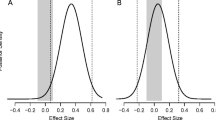Abstract
The estimation of the location and magnitude of the optimum has long been considered as an important problem in the realm of response surface methodology. In this paper, we consider the Bayes estimates in a single factor quadratic response function, after a reparametrization from the linear model, using noninformative priors. The usual constant noninformative prior for the reparametrized model does not yield a proper posterior, thus it is desirable to consider other noninformative priors such as the Jeffreys prior and reference priors. Comparisons will be made based on the resulting posterior means, variances and credible intervals by examples and simulations.
Similar content being viewed by others
References
Berger, J. O. (1985).Statistical Decision Theory and Bayseian Analysis, second Edition, Springer-Verlag, New York.
Berger, J. O. and J. M. Bernardo (1989). Estimating a product of means: Bayesian analysis with reference priors.Journal of the American Statistical Association,84, 200–207.
Berger, J. O. and J. M. Bernardo (1992)a Ordered group reference priors with application to the multinomial problem.Biometrika,79, 25–37.
Berger, J. O. and J. M. Bernardo (1992b). On the development of reference priors.Bayesian Statistics, 4, pp. 35–60 (J. M. Bernardo, J. O. Berger, A. P. Dawid, and A. F. M. Smith, eds.), Oxford University Press, Oxford.
Bernardo, J. M. (1979). Reference posterior distribution for Bayesian inference.Journal of the Royal Statistical Society, B,41, 113–147.
Box, G. E. P. and N. R. Draper (1987).Empirical Model Building and Response Surfaces John Wiley, New York.
Buonaccorsi, J. P. and A. Gatsonis (1988). Baycsian inference for ratios of coefficients in a lincar model.Biometrics,44, 87–101.
Datta, G. S. and M. Ghosh (1995). Some remarks on noninformative priors.Journal of the American Statistical Association,90, 1357–1363.
Fan, T. H., M. J. Karson and H. S. Wang (1996). A Bayesian estimator of the optimun for a single factor quadratic regression model.Biom. Journal,38, 163–172.
Hoadley, B. (1970). A Bayesian look at inverse regression.Journal of the American Statistical Association,65, 357–369.
Hotelling, H. (1941). Experimental determination of the maximum of a function.Annals of Mathematical Statistics,12, 20–45.
Jeffreys, H. (1961).Theory of Probability, third edition, Oxford University Press, London.
Khuri, A. I. and J. A. Cornell (1987).Response Surfaces, Marcel Dekker, New York.
Laplace, P. S. (1812).Theorie Analytique des Probabilities, Courcier, Paris.
Mandal, N. K. (1978). On estimation of the maximal point of a single factor function.Calcuta Statistical Bulletin,27, 119–125.
Mee, R. and S. Sapp (1992). Estimation of the optimum, assuming a quadratic model. Presented in theJoint Statistitical Meetings Boston.
Seber, G. A. F. and C. J. Wild (1989).Nonlinear Regression, John Wiley, New York.
Wang, H. S. and M. J. Karson (1985). The OLSE and MLE of maximum point of single factor quadratic regression function.Journal of the Chinesse Statistical Association,23, 75–101.
Wang, H. S. and M. J. Karson (1991). LIME: The lest integrated mean-squareerror estimation for the maximum point of the single factor quadratic regression function.Communications in Statistics, Simmulation and Computing,20, 41–72.
Ye, K. and J. O. Berger (1991). Noninformative priors for inference in exponential regression models.Biometrika,78, 645–656.
Author information
Authors and Affiliations
Corresponding author
Additional information
This work has been supported by the National Science Council, Grants NSC88-2118-M008-009, in Taiwan.
Rights and permissions
About this article
Cite this article
Fan, TH. Noninformative bayesian estimation for the optimum in a single factor quadratic response model. Test 10, 225–240 (2001). https://doi.org/10.1007/BF02595694
Received:
Accepted:
Issue Date:
DOI: https://doi.org/10.1007/BF02595694
Key Words
- Credible interval
- Jeffreys prior, noninformative prior
- posterior mean
- posterior variance
- reference prior
- response surface




